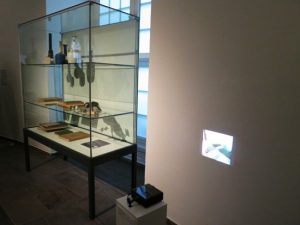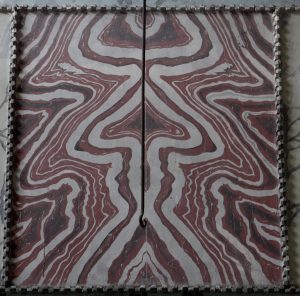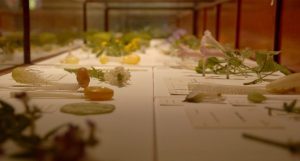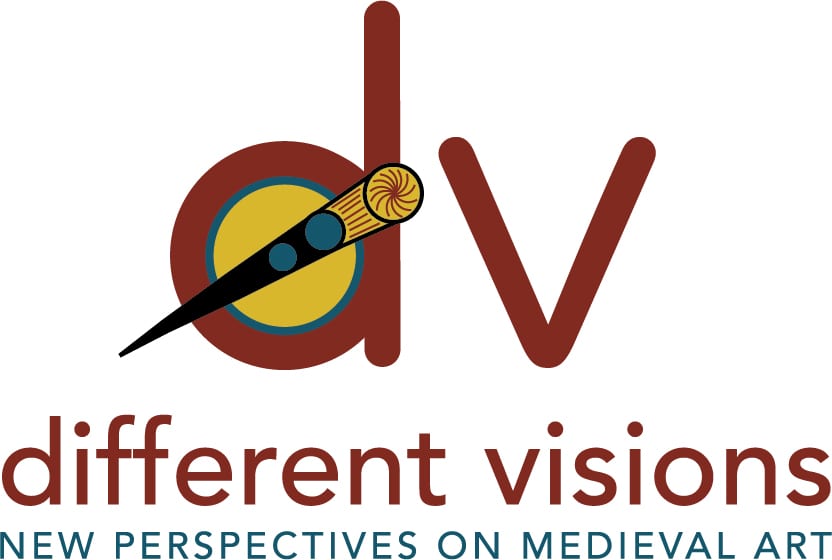The primary reason[1] I was at CAA was to co-chair the session “Objects, Objectives, Objections: The Goals and Limits of the New Materialisms in Art History,” which I organized with Bibiana Obler of George Washington University (who, incidentally, has a brilliant and gorgeous new book out). The session arose out of conversations Bibi and I had around Jane Bennett’s book Vibrant Matter and the speed with which that book insinuated itself into the thought of art historians and scholars we knew in other fields. It was perhaps the latter group that most inspired us; we were struck by how scholars of literature, philosophy, political science, etc., began spending more and more time thinking about things. “Hey… That’s what art historians do!” These New Materialist approaches felt familiar to our workaday practice as art historians but also in some ways quite different; we also found, in talking it through, that I as a medievalist and Bibi as a modernist responded to Bennett’s ideas, and New Materialism more broadly, in different and sometimes divergent ways. We thought that it would be useful, in the context of CAA, to think about what art historians have to offer New Materialisms, and what New Materialisms may have to offer art history.
After sifting through dozens of proposals, and having a request for a second session denied by the conference organizing committee, we assembled a group of five papers that came at the question from very different perspectives, and with varying degrees of enthusiasm for New Materialist approaches:
- Prita Meier (University of Illinois-Urbana Champaign), “Object Lessons from East Africa”
- Jessica L. Horton (Smithsonian American Art Museum & National Museum of the American Indian), “Paris/Ojibwa: Towards a Transcultural Materialism”
- Freyja T. Hartzell (Parsons, The New School for Design), “Things and Their Thingliness: Object Agency in the Designs of Richard Riemerschmid”
- Susan Jarosi (University of Louisville), “Documenta 13: The Rise of the Vitrines”
- Michael Schreyach (Trinity University), “New Materialism’s Renunciation of Meaning”
Each of the papers merits a sustained consideration on its own, but here I’d just like to draw out some interesting commonalities. Horton and Hartzell’s papers both emphasized that there have always been many theories of things, whether it’s among the post-contact Ojibwa or early 20th c. German intellectual circles, and that one of the great lasting benefits of New Materialist work might just be to remind us that things have not always been what we perceive them now to be. Meier and Horton both effectively traced how the perceived being of objects–their function, their visual and material qualities, their very definition as “thing”–could change as they moved among new cultural settings.

Installation shot from Documenta 13 (via Art IT)
Function was an important consideration, in different ways, in the papers by Hartzell, Meier, and Jarosi: in each of their papers, it was clear that function cannot be understood transparently, but as a crucial–perhaps the crucial–consideration in New Materialist work. And Jarosi and Schreyach both also argued for the very serious ways in which New Materialisms might run counter to long established aspects of museum and scholarly practice, whether the use of vitrines (much more complicated, it turns out, than you might think) or our continuing disciplinary dependence on notions of intentionality and meaning.
The discussion was lively, even though–or perhaps because?–the overcrowded room had gotten uncomfortably warm. It is clear that the New Materialisms, though they might feel familiar and be academically “hot,” still sit rather uncomfortably within art history; each of the presenters expressed some hesitancy about how profoundly this new “turn” might affect our field. This is especially true for the more radical claims advanced by Ian Bogost, Graham Harman, and other theorists of Object-Oriented Ontology, whose ideas found little play in the session. The high point for me was a very interesting question posed by Ivan Gaskell to the panel, and to Schreyach in particular: “Does any interest you may have in a thing as an artwork necessarily exhaust your interest in it?” (a great follow up post with more from Gaskell can be found here). I’m still turning this over in my head: embedded in that question, I think, is a presumption that a New Materialist should answer yes, and I think that’s my initial intuition. But I don’t know if I really mean it, mostly because my interest in things that are artworks is almost always inspired first and foremost by their status as artworks. That is to say, in my scholarly work I am far less interested in other things than I am in artworks (though I take that word rather broadly). And I don’t know if I’m actually all that interested in the fact that, as Duchamp proposed, we could use the Mona Lisa as an ironing board, or, as Michael Schreyach put it, a reliquary as a doorstop. Is this just my disciplinary tendency as an art historian, or is it because, in the end, I’m hesitant myself about the New Materialisms?

Marble Panel from the Narthex of Hagia Sophia
There were, as usual, many other excellent sessions, quite a few of them opposite each other (natch). Two in particular stood out for me. One was the first part of “The Medium Before and After Modernism,” organized by Roland Betancourt. Noting that the renewed interest in materiality seemed to be bringing along with it a revival of the idea of medium specificity, Betancourt encouraged us to consider the medium itself as an epistemological space, offering the possibility that the medium exists before the potentiality of the signifier. Finbarr Barry Flood (unfortunately in absentia due to this winter asserting its own profound agency) and Beate Fricke both presented just fascinating papers. Flood revisited the curious figuration to be found in marble panels in Islamic and Byzantine architecture, and described how this non-human medium offered a sly workaround of the prohibitions against figural imagery in Islamic sacred spaces. Fricke explored a small, absolutely absorbing, previously unpublished Netherlandish painting of the Temptation of Anthony, and in the process unpacked our disciplinary distinctions and assumptions about pictures, images, paintings, visions, space, and mentation. I can’t wait to see both essays in print.

Case of Glass Flowers, Harvard Museum of Natural History (photo by Curious Expeditions
The other session that provoked a lot of ideas for me was “Ephemeral,” organized by Carson Fox. This was a big panel, with, I think, eight speakers, but two in particular stuck out for me. One was (not at all to my surprise) my friend and former classmate Ellery Foutch’s paper on the Glass Flowers at Harvard. The Glass Flowers represent an attempt to overcome the ephemerality of plant life but, in their fragility, nonetheless remind us that entropy is inescapable; from a certain vantage point, everything is ephemeral. The other was a presentation by a member of the artists’ collective Noxious Sector about their recent series of hauntings. Stemming from something of an inside joke, the three artists have in the past few years undertaken to haunt places and people (including Canadian PM Stephen Harper), blending beautifully the human intuitive belief in the spirit world with concerns about surveillance in the electronic age. This work had a special resonance for me, as my grandfather and now my father have lived in a house understood by many (within my family and outside it) to be haunted. I’ve never quite come to terms with the implications of it–I still profess not to know if there’s such a thing as an afterlife even though I’m inclined to think that at least some of these stories are true–preferring instead to let the mystery be.[2] But on an intellectual level, I thought back to the “Medium” session and was rather intrigued by the possibilities of “haunting” as a medium. The spiritualist inflection of the word reminds us that medium exist as a means of contact just as much as a thing unto itself.
There were several other great papers and sessions, and many more that I missed. Such is the agony of CAA. As great as it is to give a lot of people a chance to share their work at the conference, I came away feeling that the conference might be too big for any real sharing, across the field as a whole, to happen. Many people went to an entirely different CAA than the one I did, and while that reflects a huge and healthy diversity of interests in our field, it’s hard not to feel like we’re still missing an opportunity to all put our heads together and think some new thoughts about things. I wouldn’t mind seeing CAA shrink a bit (and I’d be thrilled to see it move away from being a job fair): a smaller conference might promise a more intense experience, and one of more benefit to the field.
References
| ↑1 | The other reason I was at CAA was as to accompany our senior art history majors as part of Lawrence University’s Senior Experience program (funded through the generosity of the Mellon Foundation). It was a great experience seeing the conference through their eyes, as they picked up on a lot of the quirks and mannerisms of our field that I’ve come to take for granted. |
|---|---|
| ↑2 | With a tip of the hat to Iris DeMent for the wonderful phrase. |
